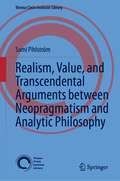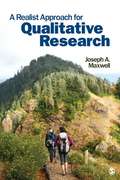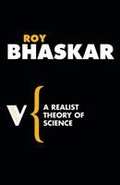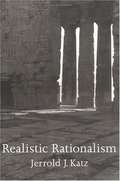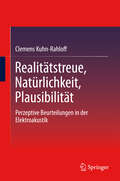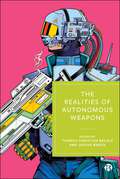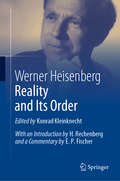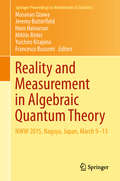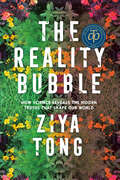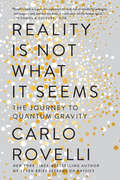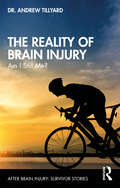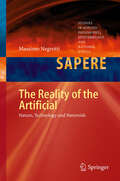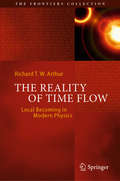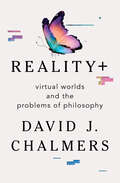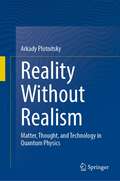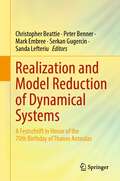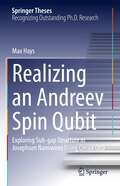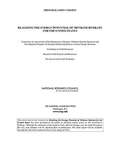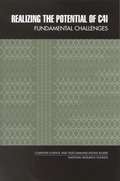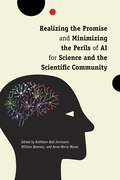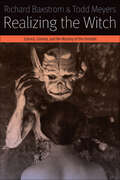- Table View
- List View
Realism, Value, and Transcendental Arguments between Neopragmatism and Analytic Philosophy (Vienna Circle Institute Library #7)
by Sami PihlströmThe essays collected in this volume and authored by Sami Pihlström emphasize that our relation to the world we live in and seek to represent and get to know better through our practices of conceptualization and inquiry is irreducibly valuational. There is no way of even approaching, let alone resolving, the philosophical issue of realism without drawing due attention to the ways in which human values are inextricably entangled with even the most purely “factual” projects of inquiry we engage in.This entanglement of the factual and the normative is, as explicitly argued in Chapter 7 but implicitly suggested in all the other chapters as well, both pragmatic (practice-embedded and practice-involving) and transcendental (operating at the level of the necessary conditions for the possibility of our representing and cognizing the world in general). The author claims we need to carefully examine the complex relations of realism, value, and transcendental arguments at the intersection of pragmatism and analytic philosophy. This book does so by offering case-studies of various important neopragmatists and philosophers close to the pragmatist tradition, including Hilary Putnam, Nicholas Rescher, Joseph Margolis, and Ludwig Wittgenstein. It appeals to scholars and advanced graduate students focusing on pragmatism and analytic philosophy.
A Realist Approach For Qualitative Research
by Joseph A. MaxwellThis ground-breaking book makes the case for adopting a realist philosophical perspective for qualitative research. Joseph Maxwell argues for critically applying a realist ontology to a number of important theoretical and methodological issues. This can provide a stronger justification for what qualitative researchers do, he contends, and significantly contribute to current theories and practices. The book outlines critical realism and considers its implications for how we conceptualize meaning and culture, causation, and diversity. The author applies critical realist ideas and approaches to the design and methods of qualitative research, and presents two in-depth case studies of projects he conducted, describing how realist (and other) perspectives informed the research, the methods, and the conclusions.
A Realist Theory of Science (Radical Thinkers)
by Roy Bhaskar<i>A Realist Theory of Science</i> is one of the few books that have changed our understanding of the philosophy of science. In this analysis of the natural sciences, with a particular focus on the experimental process itself, Roy Bhaskar provides a definitive critique of the traditional, positivist conception of science and stakes out an alternative, realist position. Since it original publication in 1975, a movement known as ‘Critical Realism’, which is both intellectually diverse and international in scope, has developed on the basis of key concepts outlined in the text. The book has been hailed in many quarters as a ‘Copernican Revolution’ in the study of the nature of science, and the implications of its account have been far-reaching for many fields of the humanities and social sciences.
The realistic empiricism of Mach, James, and Russell
by Erik C. BanksIn the early twentieth century, Ernst Mach, William James, and Bertrand Russell founded a philosophical and scientific movement known as 'neutral monism', based on the view that minds and physical objects are constructed out of elements or events which are neither mental nor physical, but neutral between the two. This movement offers a unified scientific outlook which includes sensations in human experience and events in the world of physics under one roof. In this book Erik C. Banks discusses this important movement as a whole for the first time. He explores the ways in which the three philosophers can be connected, and applies their ideas to contemporary problems in the philosophy of mind and the philosophy of science - in particular the relation of sensations to brain processes, and the problem of constructing extended bodies in space and time from particular events and causal relations.
Realistic Rationalism
by Jerrold J. KatzJerrold J. Katz develops a new philosophical position integrating realism and rationalism. Realism here means that the objects of study in mathematics and other formal sciences are abstract; rationalism means that our knowledge of them is not empirical.
Realitätstreue, Natürlichkeit, Plausibilität
by Clemens Kuhn-RahloffDieses Buch richtet sich an Ingenieure und Forscher im Bereich der Kommunikationsakustik und anderen Gebieten der Wahrnehmungsforschung. Es bewegt sich im interdisziplinären Feld von Kommunikationsakustik, Informationstheorie und Wahrnehmungspsychologie und liefert einen wesentlichen Beitrag zum Verständnis der akustischen Wahrnehmung. Im Zentrum steht dabei der Begriff der Plausibilität als grundlegender Bestandteil kommunikationsakustischer Technik. Um Eigenschaften von Plausibilitätsurteilen bei der akustischen Wahrnehmung zu von Menschen zu erörtern, stellt das Buch ausgewählte top-down-Prozesse der Wahrnehmung in den Vordergrund, die das Urteilsverhalten beeinflussen. Plausibilität wird im Kontext existierender Modelle für perzeptive Messungen dargestellt und die Anforderungen werden diskutiert, die an den Begriff gestellt werden, wenn er im psychoakustischen Sinn als Messgröße aufgefasst wird.
The Realities of Autonomous Weapons
by Thomas Christian Bächle and Jascha BareisAvailable open access digitally under CC-BY-NC-ND licence. The realities of autonomous weapons are a complex blend of both existing military technologies and visions of their future capabilities. The expected ramifications are profound and always point to the interplay between fact and fiction, actual developments and creative imagination. This book explores how these realities shape and become themselves shaped by popular culture, regulatory and ethics debates, military doctrines, policies and research. It examines phenomena ranging from film and artistic interpretations to warfare scenarios and weaponized artificial intelligence. Intended for researchers (including the disciplines of political and social sciences, media, culture and technology), policy makers, educators and journalists, this is a key resource that uncovers how autonomous weapons are constructed as both a technological reality and a futuristic possibility.
Reality and Its Order
by Werner HeisenbergAvailable here for the first time in English, "Reality and Its Order" is a remarkable philosophical text by Werner Heisenberg, the father of quantum mechanics and one of the leading scientists of the 20th century. Written during the wartime years and initially distributed only to his family and trusted friends, the essay describes Heisenberg’s philosophical view of how we understand the natural world and our role within it. In this volume, the essay is introduced by the physicist Helmut Rechenberg and annotated by the science historian Ernst Peter Fischer. The content, particularly within its historical context, will be of great interest to many physicists, philosophers and historians of science.
Reality and Measurement in Algebraic Quantum Theory: Nagoya, Japan, March 9-13 2015 (Springer Proceedings in Mathematics & Statistics #261)
by Masanao Ozawa Jeremy Butterfield Hans Halvorson Miklós Rédei Yuichiro Kitajima Francesco BuscemiThis volume contains papers based on presentations at the “Nagoya Winter Workshop 2015: Reality and Measurement in Algebraic Quantum Theory (NWW 2015)”, held in Nagoya, Japan, in March 2015. The foundations of quantum theory have been a source of mysteries, puzzles, and confusions, and have encouraged innovations in mathematical languages to describe, analyze, and delineate this wonderland. Both ontological and epistemological questions about quantum reality and measurement have been placed in the center of the mysteries explored originally by Bohr, Heisenberg, Einstein, and Schrödinger. This volume describes how those traditional problems are nowadays explored from the most advanced perspectives. It includes new research results in quantum information theory, quantum measurement theory, information thermodynamics, operator algebraic and category theoretical foundations of quantum theory, and the interplay between experimental and theoretical investigations on the uncertainty principle. This book is suitable for a broad audience of mathematicians, theoretical and experimental physicists, and philosophers of science.
The Reality Bubble: Blind Spots, Hidden Truths, and the Dangerous Illusions that Shape Our World
by Ziya TongFrom one of the world's most engaging science journalists, a groundbreaking and wonder-filled look at the hidden things that shape our lives in unexpected and sometimes dangerous ways.Our naked eyes see only a thin sliver of reality. We are blind in comparison to the X-rays that peer through skin, the mass spectrometers that detect the dead inside the living, or the high-tech surveillance systems that see with artificial intelligence.And we are blind compared to the animals that can see in infrared, or ultraviolet, or in 360-degree vision. These animals live in the same world we do, but they see something quite different when they look around.With all of the curiosity and flair that drives her broadcasting, Ziya Tong illuminates this hidden world, and takes us on a journey to examine ten of humanity's biggest blind spots.First, we are introduced to the blind spots we are all born with, to see how technology reveals an astonishing world that exists beyond our human senses. It is with these new ways of seeing that today's scientists can image everything from an atom to a black hole. In Section Two, our collective blind spots are exposed. It's not that we can't see, Tong reminds us. It's that we don't. In the 21st century, there are cameras everywhere, except where our food comes from, where our energy comes from, and where our waste goes. Being in the dark when it comes to how we survive makes it impossible to navigate our future.Lastly, the scope widens to our civilizational blind spots. Here, the blurred lens of history reveals how we inherit ways of thinking about the world that seem natural or inevitable but are in fact little more than traditions, ways of seeing the world that have come to harm it. This vitally important new book shows how science, and the curiosity that drives it, can help civilization flourish by opening our eyes to the landscape laid out before us. Fast-paced, utterly fascinating, and deeply humane, The Reality Bubble gives voice to the sense we've all had -- that there is more to the world than meets the eye.
Reality Check: How Science Deniers Threaten Our Future
by Donald R. ProtheroA thought-provoking look at science denialism &“for popular science readers who want better to be able to explain and defend science and scientific methods to others&” (Library Journal). The battles over evolution, climate change, childhood vaccinations, and the causes of AIDS, alternative medicine, oil shortages, population growth, and the place of science in our country—all are reaching a fevered pitch. Many people and institutions have exerted enormous efforts to misrepresent or flatly deny demonstrable scientific reality to protect their nonscientific ideology, their power, or their bottom line. To shed light on this darkness, Donald R. Prothero explains the scientific process and why society has come to rely on science not only to provide a better life but also to reach verifiable truths no other method can obtain. He describes how major scientific ideas that are accepted by the entire scientific community (evolution, anthropogenic global warming, vaccination, the HIV cause of AIDS, and others) have been attacked with totally unscientific arguments and methods. Prothero argues that science deniers pose a serious threat to society, as their attempts to subvert the truth have resulted in widespread scientific ignorance, increased risk of global catastrophes, and deaths due to the spread of diseases that could have been prevented. &“Prothero&’s treatise will give the science-minded something to cheer about, a brief summary of the real data that supports so many critical aspects of modern life.&” —Publishers Weekly
Reality Is Not What It Seems: The Journey to Quantum Gravity
by Carlo Rovelli Erica Segre Simon Carnell<P><P>From the New York Times–bestselling author of Seven Brief Lessons on Physics, a closer look at the mind-bending nature of the universe.What are the elementary ingredients of the world? Do time and space exist? And what exactly is reality? <P><P>Theoretical physicist Carlo Rovelli has spent his life exploring these questions. He tells us how our understanding of reality has changed over the centuries and how physicists think about the structure of the universe today. <P><P>In elegant and accessible prose, Rovelli takes us on a wondrous journey from Democritus to Albert Einstein, from Michael Faraday to gravitational waves, and from classical physics to his own work in quantum gravity. <P><P>As he shows us how the idea of reality has evolved over time, Rovelli offers deeper explanations of the theories he introduced so concisely in Seven Brief Lessons on Physics. <P><P>This book culminates in a lucid overview of quantum gravity, the field of research that explores the quantum nature of space and time, seeking to unify quantum mechanics and general relativity. <P><P>Rovelli invites us to imagine a marvelous world where space breaks up into tiny grains, time disappears at the smallest scales, and black holes are waiting to explode—a vast universe still largely undiscovered.
The Reality of Brain Injury: Am I Still Me? (After Brain Injury: Survivor Stories)
by Andrew TillyardA respected medical professional, family man, and keen athlete, Andrew Tillyard had a full and active life until a vehicle crash changed it all. He sustained a serious head injury and was airlifted to the hospital where he worked, having only just survived. In this book, he recounts the raw, uncompromising struggles he faced to rebuild his life. Drawing from regular blog entries written throughout his rehabilitation, Andrew provides an authentic reflection of the lived experience at some of the key stages along the road to recovery, from pragmatic concerns about new daily difficulties to wider concerns about his new place in life. He highlights the specific challenges and support he encountered as a person with a medical background who finds themselves in a healthcare system as a patient. With frank honesty, he takes readers beyond the simple message that things can and do improve, by demonstrating that negativity, bitterness, and occasional rage are all necessary parts of the journey. However, he also describes the many little victories that helped him keep battling on, knowing there is always hope for the future. In particular, he narrates how he learnt to do things the doctors said he would never do: walking, reading, running, and ultimately writing this book. With the perspective of ten years since his injury, the book also charts a longer-term view of the ebb and flow of recovery. This is essential reading for neuropsychologists, neurologists, and other rehabilitation therapists, as well as students in medicine, nursing, allied health, and neuropsychology. This is also a compelling and compassionate story for anyone who has survived a brain injury, who feels – as Andrew did at times – that life might not be worth living anymore, as it can show that there is always hope for the future.
The Reality of the Artificial
by Massimo NegrottiThe human ambition to reproduce and improve natural objects and processes has a long history, and ranges from dreams to actual design, from Icarus's wings to modern robotics and bioengineering. This imperative seems to be linked not only to practical utility but also to our deepest psychology. Nevertheless, reproducing something natural is not an easy enterprise, and the actual replication of a natural object or process by means of some technology is impossible. In this book the author uses the term naturoid to designate any real artifact arising from our attempts to reproduce natural instances. He concentrates on activities that involve the reproduction of something existing in nature, and whose reproduction, through construction strategies which differ from natural ones, we consider to be useful, appealing or interesting. The development of naturoids may be viewed as a distinct class of technological activity, and the concept should be useful for methodological research into establishing the common rules, potentialities and constraints that characterize the human effort to reproduce natural objects. The author shows that a naturoid is always the result of a reduction of the complexity of natural objects, due to an unavoidable multiple selection strategy. Nevertheless, the reproduction process implies that naturoids take on their own new complexity, resulting in a transfiguration of the natural exemplars and their performances, and leading to a true innovation explosion. While the core performances of contemporary naturoids improve, paradoxically the more a naturoid develops the further it moves away from its natural counterpart. Therefore, naturoids will more and more affect our relationships with advanced technologies and with nature, but in ways quite beyond our predictive capabilities. The book will be of interest to design scholars and researchers of technology, cultural studies, anthropology and the sociology of science and technology.
The Reality of Time Flow: Local Becoming in Modern Physics (The Frontiers Collection)
by Richard T. ArthurIt is commonly held that there is no place for the 'now’ in physics, and also that the passing of time is something subjective, having to do with the way reality is experienced but not with the way reality is. Indeed, the majority of modern theoretical physicists and philosophers of physics contend that the passing of time is incompatible with modern physical theory, and excluded in a fundamental description of physical reality. This book provides a forceful rebuttal of such claims. In successive chapters the author explains the historical precedents of the modern opposition to time flow, giving careful expositions of matters relevant to becoming in classical physics, the special and general theories of relativity, and quantum theory, without presupposing prior expertise in these subjects. Analysing the arguments of thinkers ranging from Aristotle, Russell, and Bergson to the proponents of quantum gravity, he contends that the passage of time, understood as a local becoming of events out of those in their past at varying rates, is not only compatible with the theories of modern physics, but implicit in them.
Reality+: Virtual Worlds and the Problems of Philosophy
by David J. ChalmersA leading philosopher takes a mind-bending journey through virtual worlds, illuminating the nature of reality and our place within it. Virtual reality is genuine reality; that’s the central thesis of Reality+. In a highly original work of “technophilosophy,” David J. Chalmers gives a compelling analysis of our technological future. He argues that virtual worlds are not second-class worlds, and that we can live a meaningful life in virtual reality. We may even be in a virtual world already. Along the way, Chalmers conducts a grand tour of big ideas in philosophy and science. He uses virtual reality technology to offer a new perspective on long-established philosophical questions. How do we know that there’s an external world? Is there a god? What is the nature of reality? What’s the relation between mind and body? How can we lead a good life? All of these questions are illuminated or transformed by Chalmers’ mind-bending analysis. Studded with illustrations that bring philosophical issues to life, Reality+ is a major statement that will shape discussion of philosophy, science, and technology for years to come.
Reality Without Realism: Matter, Thought, and Technology in Quantum Physics
by Arkady PlotnitskyThis book presents quantum theory as a theory based on new relationships among matter, thought, and experimental technology, as against those previously found in physics, relationships that also redefine those between mathematics and physics in quantum theory. The argument of the book is based on its title concept, reality without realism (RWR), and in the corresponding view, the RWR view, of quantum theory. The book considers, from this perspective, the thinking of Bohr, Heisenberg, Schrödinger, and Dirac, with the aim of bringing together the philosophy and history of quantum theory. With quantum theory, the book argues, the architecture of thought in theoretical physics was radically changed by the irreducible role of experimental technology in the constitution of physical phenomena, accordingly, no longer defined independently by matter alone, as they were in classical physics or relativity. Or so it appeared. For, quantum theory, the book further argues, made us realize that experimental technology, beginning with that of our bodies, irreducibly shapes all physical phenomena, and thus makes us rethink the relationships among matter, thought, and technology in all of physics.
Reality’s Fugue: Reconciling Worldviews in Philosophy, Religion, and Science
by F. Samuel BrainardScience, religion, philosophy: these three categories of thought have organized humankind’s search for meaning from time immemorial. Reality’s Fugue presents a compelling case that these ways of understanding, often seen as competing, are part of a larger puzzle that cannot be rendered by one account of reality alone.This book begins with an overview of the concept of reality and the philosophical difficulties associated with attempts to account for it through any single worldview. By clarifying the differences among first-person, third-person, and dualist understandings of reality, F. Samuel Brainard repurposes the three predominant ways of making sense of those differences: exclusionist (only one worldview can be right), inclusivist (viewing other worldviews through the lens of one in order to incorporate them all, and thus distorting them), and pluralist or relativist (holding that there are no universals, and truth is relative). His alternative mode of understanding uses Douglas Hofstadter’s metaphor of a musical fugue that allows different “voices” and “melodies” of worldviews to coexist in counterpoint and conversation, while each remains distinct, with none privileged above the others. Approaching reality in this way, Brainard argues, opens up the possibility for a multivoiced perspective that can overcome the skeptical challenges that metaphysical positions face.Engagingly argued by a lifelong scholar of philosophy and global religions, this edifying and accessible exploration of the nature of reality addresses deeply meaningful questions about belief, reconciliation, and being.
Reality’s Fugue: Reconciling Worldviews in Philosophy, Religion, and Science
by F. Samuel BrainardScience, religion, philosophy: these three categories of thought have organized humankind’s search for meaning from time immemorial. Reality’s Fugue presents a compelling case that these ways of understanding, often seen as competing, are part of a larger puzzle that cannot be rendered by one account of reality alone.This book begins with an overview of the concept of reality and the philosophical difficulties associated with attempts to account for it through any single worldview. By clarifying the differences among first-person, third-person, and dualist understandings of reality, F. Samuel Brainard repurposes the three predominant ways of making sense of those differences: exclusionist (only one worldview can be right), inclusivist (viewing other worldviews through the lens of one in order to incorporate them all, and thus distorting them), and pluralist or relativist (holding that there are no universals, and truth is relative). His alternative mode of understanding uses Douglas Hofstadter’s metaphor of a musical fugue that allows different “voices” and “melodies” of worldviews to coexist in counterpoint and conversation, while each remains distinct, with none privileged above the others. Approaching reality in this way, Brainard argues, opens up the possibility for a multivoiced perspective that can overcome the skeptical challenges that metaphysical positions face.Engagingly argued by a lifelong scholar of philosophy and global religions, this edifying and accessible exploration of the nature of reality addresses deeply meaningful questions about belief, reconciliation, and being.
Realization and Model Reduction of Dynamical Systems: A Festschrift in Honor of the 70th Birthday of Thanos Antoulas
by Christopher Beattie Peter Benner Mark Embree Serkan Gugercin Sanda LefteriuThis book celebrates Professor Thanos Antoulas's 70th birthday, marking his fundamental contributions to systems and control theory, especially model reduction and, more recently, data-driven modeling and system identification. Model reduction is a prominent research topic with wide ranging scientific and engineering applications.
Realizing an Andreev Spin Qubit: Exploring Sub-gap Structure in Josephson Nanowires Using Circuit QED (Springer Theses)
by Max HaysThe thesis gives the first experimental demonstration of a new quantum bit (“qubit”) that fuses two promising physical implementations for the storage and manipulation of quantum information – the electromagnetic modes of superconducting circuits, and the spins of electrons trapped in semiconductor quantum dots – and has the potential to inherit beneficial aspects of both. This new qubit consists of the spin of an individual superconducting quasiparticle trapped in a Josephson junction made from a semiconductor nanowire. Due to spin-orbit coupling in the nanowire, the supercurrent flowing through the nanowire depends on the quasiparticle spin state. This thesis shows how to harness this spin-dependent supercurrent to achieve both spin detection and coherent spin manipulation. This thesis also represents a significant advancement to our understanding and control of Andreev levels and thus of superconductivity. Andreev levels, microscopic fermionic modes that exist in all Josephson junctions, are the microscopic origin of the famous Josephson effect, and are also the parent states of Majorana modes in the nanowire junctions investigated in this thesis. The results in this thesis are therefore crucial for the development of Majorana-based topological information processing.
Realizing the Energy Potential of Methane Hydrate for the United States
by National Research Council of the National AcademiesNatural gas, composed mostly of methane, is the cleanest of all the fossil fuels, emitting 25-50% less carbon dioxide than either oil or coal for each unit of energy produced. In recent years, natural gas supplied approximately 20-25% of all energy consumed in the United States. Methane hydrate is a potentially enormous and as yet untapped source of methane. The Department of Energy's Methane Hydrate Research and Development Program has been tasked since 2000 to implement and coordinate a national methane hydrate research effort to stimulate the development of knowledge and technology necessary for commercial production of methane from methane hydrate in a safe and environmentally responsible way. Realizing the Energy Potential of Methane Hydrate for the United States evaluates the program's research projects and management processes since its congressional re-authorization in 2005, and presents recommendations for its future research and development initiatives.
Realizing the Potential of C4I: Fundamental Challenges
by Committee to Review DOD C4I Plans ProgramsRapid progress in information and communications technologies is dramatically enhancing the strategic role of information, positioning effective exploitation of these technology advances as a critical success factor in military affairs. These technology advances are drivers and enablers for the "nervous system" of the military—its command, control, communications, computers, and intelligence (C4I) systems—to more effectively use the "muscle" side of the military.Authored by a committee of experts drawn equally from the military and commercial sectors, Realizing the Potential of C4I identifies three major areas as fundamental challenges to the full Department of Defense (DOD) exploitation of C4I technology—information systems security, interoperability, and various aspects of DOD process and culture. The book details principles by which to assess DOD efforts in these areas over the long term and provides specific, more immediately actionable recommendations. Although DOD is the focus of this book, the principles and issues presented are also relevant to interoperability, architecture, and security challenges faced by government as a whole and by large, complex public and private enterprises across the economy.
Realizing the Promise and Minimizing the Perils of AI for Science and the Scientific Community
by Kathleen Hall Jamieson, William Kearney, and Anne-Marie MazzaRecommendations from the scientific community to ensure that the development and use of AI honors scientific normsIn late 2022, OpenAI released ChatGPT, an AI chatbot capable of generating conversational answers and analyses, as well as images, in response to user questions and prompts. This generative AI is built with computational procedures, such as large language models, that train on vast bodies of human-created and curated data, including huge amounts of scientific literature. Since then, the worry that AI may someday outsmart humans has only grown more widespread.In the past, as society grappled with the implications of new technologies—ranging from nuclear energy to recombinant DNA—the scientific community developed practices designed to increase adherence to the norms that have protected the integrity of each new form of scientific exploration, development, and deployment. In the process, scientists expanded their community’s repertoire of mechanisms designed to advance emerging science and technology while safeguarding the integrity of science and the wellbeing of the nation and its people.This book provides a historical perspective on and an ethical approach to emerging AI technologies; an overview of AI frameworks and principles; and an assessment of AI’s current advances, hurdles, and potential. Experts from the fields of behavioral and social sciences, ethics, biology, physics, chemistry, mathematics, and computer science, as well as leaders in higher education, law, governance, and science publishing and communication, comprise the book’s contributors. Their essays remind us that, even as our understandings of emerging technologies and of their implications evolve, science’s commitment to core norms and values remains steadfast. The volume’s conclusion advocates for following principles of human accountability and responsibility when using artificial intelligence in research, including transparent disclosure and attribution; verification and documentation of AI-generated data and analysis; a focus on ethics and equity; and continuous oversight and public engagement.
Realizing the Witch: Science, Cinema, and the Mastery of the Invisible (Forms of Living)
by Richard Baxstrom Todd MeyersBenjamin Christensen’s Häxan (The Witch, 1922) stands as a singular film within the history of cinema. Deftly weaving contemporary scientific analysis and powerfully staged historical scenes of satanic initiation, confession under torture, possession, and persecution, Häxan creatively blends spectacle and argument to provoke a humanist re-evaluation of witchcraft in European history as well as the contemporary treatment of female “hysterics” and the mentally ill.In Realizing the Witch, Baxstrom and Meyers show how Häxan opens a window onto wider debates in the 1920s regarding the relationship of film to scientific evidence, the evolving study of religion from historical and anthropological perspectives, and the complex relations between popular culture, artistic expression, and concepts in medicine and psychology. Häxan is a film that travels along the winding path of art and science rather than between the narrow division of “documentary” and “fiction.” Baxstrom and Meyers reveal how Christensen’s attempt to tame the irrationality of “the witch” risked validating the very "nonsense" that such an effort sought to master and dispel. Häxan is a notorious, genre-bending, excessive cinematic account of the witch in early modern Europe. Realizing the Witch not only illustrates the underrated importance of the film within the canons of classic cinema, it lays bare the relation of the invisible to that which we cannot prove but nevertheless “know” to be there.
